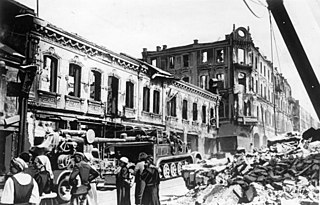
Operation Bagration was the codename for the 1944 Soviet Byelorussian strategic offensive operation, a military campaign fought between 22 June and 19 August 1944 in Soviet Byelorussia in the Eastern Front of World War II, just over two weeks after the start of Operation Overlord in the west, causing Nazi Germany to have to fight on two major fronts at the same time. The Soviet Union destroyed 28 of 34 divisions of Army Group Centre and completely shattered the German front line. It was the biggest defeat in German military history, with around 450,000 German casualties, while 300,000 other German soldiers were cut off in the Courland Pocket.

The Battle of Moscow was a military campaign that consisted of two periods of strategically significant fighting on a 600 km (370 mi) sector of the Eastern Front during World War II, between September 1941 and January 1942. The Soviet defensive effort frustrated Hitler's attack on Moscow, the capital and largest city of the Soviet Union. Moscow was one of the primary military and political objectives for Axis forces in their invasion of the Soviet Union.
Army Group Centre was the name of two distinct strategic German Army Groups that fought on the Eastern Front in World War II. The first Army Group Centre was created during the planning of Operation Barbarossa, Germany's invasion of the Soviet Union, as one of the three German Army formations assigned to the invasion.

The Western Front was a front of the Red Army, one of the Red Army Fronts during World War II.

The 4th Army was a field army of the Wehrmacht during World War II.

The 9th Army was a World War II field army. It was activated on 15 May 1940 with General Johannes Blaskowitz in command.

Gotthard Fedor August Heinrici was a German general during World War II. Heinrici is considered to have been the premier defensive expert of the Wehrmacht. His final command was Army Group Vistula, formed from the remnants of Army Group A and Army Group Center to defend Berlin from the Soviet armies advancing from the Vistula River.

The 78th Infantry Division, later known as the 78th Assault Division, was a German infantry formation which fought during World War II. After the 78th Assault Division was destroyed near Minsk in July 1944, the 78th Volksgrenadier Division was created.

The 4th Panzer Army, operating as Panzer Group 4 from its formation on 15 February 1941 to 1 January 1942, was a German panzer formation during World War II. As a key armoured component of the Wehrmacht, the army took part in the crucial battles of the German-Soviet war of 1941–45, including Operation Barbarossa, the Battle of Moscow, the Battle of Stalingrad, the Battle of Kursk, and the 1943 Battle of Kiev.

The Battle of the Caucasus was a series of Axis and Soviet operations in the Caucasus as part of the Eastern Front of World War II. On 25 July 1942, German troops captured Rostov-on-Don, opening the Caucasus region of the southern Soviet Union to the Germans and threatening the oil fields beyond at Maikop, Grozny, and ultimately Baku. Two days prior, Adolf Hitler had issued a directive to launch an operation into the Caucasus named Operation Edelweiß. German forces were compelled to withdraw from the area that winter as Operation Little Saturn threatened to cut them off.

The Battle of Białystok–Minsk was a German strategic operation conducted by the Wehrmacht's Army Group Centre under Field Marshal Fedor von Bock during the penetration of the Soviet border region in the opening stage of Operation Barbarossa, lasting from 22 June to 9 July 1941.

The 17th Panzer Division was a formation of the Wehrmacht in World War II. It was formed in November 1940 from the 27th Infantry Division. It took part in Operation Barbarossa, the invasion of the Soviet Union in June 1941, and in the winter of 1941–42 participated in the Battle of Moscow. In November 1942, the division was sent to the southern sector of the Eastern Front where it participated in Operation Winter Storm, the failed attempt to relieve the surrounded troops at Stalingrad. The division was held in reserve during the Battle of Kursk in 1943, and thereafter retreated through Ukraine and Poland, before ending the war in Czechoslovakia.

The second Smolensk operation was a Soviet strategic offensive operation conducted by the Red Army as part of the Summer-Autumn Campaign of 1943. Staged almost simultaneously with the Lower Dnieper Offensive, the offensive lasted two months and was led by General Andrei Yeremenko, commanding the Kalinin Front, and Vasily Sokolovsky, commanding the Western Front. Its goal was to clear the German presence from the Smolensk and Bryansk regions. Smolensk had been under German occupation since the first Battle of Smolensk in 1941.
The XXVII Corps was an infantry corps in the German army. It fought in several notable actions during World War II.

The Vitebsk–Orsha offensive was part of the Belorussian strategic offensive of the Red Army in summer 1944, commonly known as Operation Bagration. During the offensive, Soviet troops captured Vitebsk and Orsha. A Soviet breakthrough during the offensive helped achieve the encirclement of German troops in the subsequent Minsk offensive.
The Red Army's 33rd Army was a Soviet field army during the Second World War. It was disbanded by being redesignated HQ Smolensk Military District in 1945.

The 88th Infantry Division was a major fighting formation of the German Army (Wehrmacht). It was created in December 1939, and first saw combat in the Battle of France, and was then posted to security duties. From December 1941, the division was shifted to the southern sector of the Eastern Front, where it fought until February 1944 when it was encircled near Cherkassy and virtually destroyed.
The 220th Rifle Division was briefly a Red Army motorized infantry division that was re-organised shortly after the German invasion as a standard rifle division.
The 88th Rifle Division was twice formed as an infantry division of the Red Army, first as part of the prewar buildup of forces. In its first formation in the far north it had an unusual shtat probably to facilitate its movement in the roadless tundra and forests of that region. During the Winter War against Finland it saw action in the fighting around Salla. Its organization again proved beneficial in the spring of 1942 during the first stages of the Great Patriotic War. It played a large role in holding and then pushing back the Finnish III Army Corps during Operation Silver Fox and for this success was redesignated as the 23rd Guards Rifle Division.
The 65th Guards Rifle Division was formed as an elite infantry division of the Red Army in May, 1943, based on the 2nd formations of the 75th and 78th Rifle Brigades, and served in that role until after the end of the Great Patriotic War. Along with its "sister", the 56th Guards Rifle Division, the 65th was formed "out of sequence", that is, many Guards rifle divisions were higher numbered and formed earlier than the 65th. The division was immediately assigned to the 19th Guards Rifle Corps of the 10th Guards Army and remained under those headquarters for the duration of the war. It first saw action in Western Front's summer offensive, Operation Suvorov. During the winter of 1943-44 it took part in the stubborn fighting north and east of Vitebsk, first in Western and later in 2nd Baltic Front. During the following summer offensives it helped break through the defenses of the German Panther Line and advanced into the Baltic states, eventually receiving a battle honor for its part in the liberation of Riga. For the rest of the war it was part of the forces blockading the remnants of German Army Group North in the Courland Pocket in Latvia, eventually in Leningrad Front. After the war the 65th Guards was moved to Estonia where it was disbanded in 1947.














